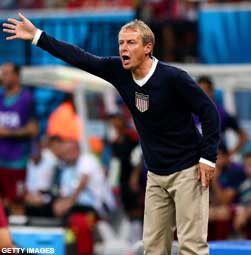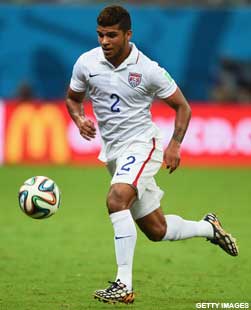Upon the U.S. team's exit from the FIFA World Cup on Tuesday, the marketability of team members likely reached its crescendo -- at least for the near future. Accordingly, THE DAILY conducted a roundtable Q&A with four marketing experts regarding how things will play out from a sponsorship perspective over the coming weeks, months and years for U.S. soccer players, the U.S. Soccer Federation and MLS. The panel consists of Baker Street Advertising Senior VP & Exec Creative Dir Bob Dorfman; rEvolution President & CEO John Rowady; Fansource Strategy Founder & CEO Lisa Bregman, who is still on the ground in Brazil; and Temple Univ. School of Tourism & Hospitality Management assistant professor Thilo Kunkel.
 |
Klinsmann's decision to leave Landon Donovan off
the team shows he can make unpopular moves |
Q: As the U.S. team heads out of the World Cup, what members of the team appear to you to have gained the most marketability during the tournament and why?
Dorfman: The clear U.S. star to emerge in Brazil was Tim Howard, whose phenomenal performance against Belgium made him a household name and face, and may have earned him as much as $1M a year in new marketing opportunities. Howard now qualifies to pitch any product that deals with saving, security, defense or protection -- from insurance to deodorant, financial services to bug repellent. And he’s got the bod for any men’s grooming product. He’s also squeaky clean -- a safe choice for advertisers nervous about the Tiger Woods Effect. Look for current sponsor Nike to feature Howard more in their marketing efforts. Howard’s only drawback is that he’s signed with the EPL’s Everton until 2018, so his visibility to casual soccer fans in the U.S. will be limited. And, at age 35, his playing future may be limited. Clint Dempsey is a close second to Howard in marketing muscle; while his performance in Brazil was less spectacular, he plays at home for the Sounders, already has a solid endorsement resume, and will be easier to follow until the next World Cup comes around.
Bregman: It should be noted that Tim Howard, who started his Twitter account on May 29, already has more than half a million followers on the platform. He also has a Facebook page with nearly 500K and an Instagram account with 212K. As far as specific categories, I've always firmly believed that the sponsor should align with personal characteristics and interests of the player as well as their brand. In Tim's case, his personal story about overcoming the challenges of Tourette Syndrome is one he’s always been very candid about and aligns with words like "legend", "hero" and "lion-hearted" that were used frequently in recaps from Tuesday's game. He’s someone young players and even adults can look up to as a person who overcame adversity to accomplish incredible things, a story most endorsing brands would want to be aligned with, regardless of category.
Rowady: DeAndre Yedlin for less obvious reasons. He was consistently a sparkplug as a sub. His selection to the team was unexpected, but he contributed at a high level on the biggest stage with his lightning fast quickness and energy. He returns to Seattle, America’s most fervent soccer market, as one of the nation’s brightest young stars. Having a blonde Mohawk doesn’t hurt his visibility too much, either. Omar Gonzalez also had a great tournament. He lost his roster spot over an injury and a few shaky performances, but absolutely solidified his selection while in Brazil. He’s MLS’ premier defender, and a Mexican-American playing in the perfect market for it -- Los Angeles. He’s going to be a prominent figure in the sport in America for the entire next cycle and one of our mature leaders going forward. His partnership with Chipotle currently is a great fit.
Kunkel: Jurgen Klinsmann. In regards of team performance, he has given the team a solid structure, especially in the midfield, and made good substitutions that positively impacted the games. In regards to team culture, he followed his approach of innovation and is a strong leader who is not afraid of unpopular decisions, such as leaving Landon Donovan at home, and selecting players with a perspective, such as Julian Green. Potential sponsors would want to associate themselves with: innovation, structural change, leadership, future/ long-term perspective. Also, Jermaine Jones: His nickname in German -- “Das Kampfschwein” (“the fighting pig”) -- gives a clear indication of his style of play, which is what the U.S. consumer wants -- he is tough, never gives up, and fights for the team. These are the characteristics potential sponsors would want to associate with. However, in the past he had trouble controlling his emotions and he can be a "loose cannon," a higher risk investment for potential sponsors.
 |
Yedlin's selection was unexpected, but he
contributed at a high level for the USMNT |
Q: Which young U.S. players do you foresee as genuinely having a big marketing upside to look forward to over the next few years, even if they have not necessarily achieved such status yet?
Dorfman: The three young U.S. team members who made strong impressions in Brazil, and offer the most marketing potential, are Julian Green, John Brooks and DeAndre Yedlin. But we may not see much of them until 2018. Green and Brooks play in Germany’s Bundesliga, and Seattle Sounder Yedlin is so good he may soon be snatched up by a European team. Again, the challenge with promising young American players is that the opportunities for them are far greater overseas. And don’t forget our marketable young female soccer stars. Alex Morgan and Sydney Leroux, ages 25 and 24 respectively, are talented, attractive and charismatic, and should star for the U.S. in the upcoming 2015 Women’s World Cup and 2016 Rio Olympics.
Rowady: In addition to DeAndre Yedlin, Mix Diskerud or Julian Green -- they’ve got distinctive looks and names, and the dual-national youngsters both are fan favorites in attacking roles. If either can latch on as a possible successor to the Dempsey-Altidore-Donovan generation, their upside will be huge. Someone we haven’t been introduced to yet may step in and be the next Landon Donovan or Dempsey. Four years is a long time.
Kunkel: Julian Green. Being based at Bayern Munich, a potential sponsor would not only associate with a USMNT player but also gain positive consumer associations through Green’s connection with Bayern Munich, which plays against the MLS All-Stars this summer. A potential sponsor therefore can leverage off Green’s brand relationship with the Bayern Munich brand. DeAndre Yedlin has gone the opposite route of Green’s development. He is the poster child of U.S. Soccer youth development and his case gives kids around the nation hope that the U.S. domestic youth development system has the capacity to develop World Cup players. His alignment with one of the biggest teams in the MLS, the Seattle Sounders, with a big fan base is attractive to potential sponsors, and eventually he may make a move to one of the bigger European teams. Both Green and Yedlin need to develop a more strategic approach to their personal branding and social media to increase their value to potential sponsors.
Bregman: It’s important to think about what makes a player marketable. Performance on the field is an obvious factor, but location can also be influential. That said, a player like DeAndre Yedlin, at least while playing for Seattle, may not have the global marketing appeal in the near future that someone like Julian Green could have playing in Germany for Bayern Munich. My hope is that by the next World Cup we see this changing though. We saw as many as seven MLS-based players started in a World Cup game for the U.S. this year and with the talent level in MLS continuing to grow, my assumption is that within a few years many non-MLS supporting U.S. Soccer fans will take notice of their local clubs as Americans playing oversees return home sooner or don’t go at all.





